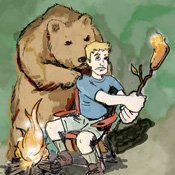Before you leave on your camping trip, pack accordingly (see "What to Pack For Camping," link) so you'll be prepared for unforeseen challenges. Then, let a responsible person know exactly where you are going and when you expect to return.
Even if you prepare with the right knowledge and equipment, you may still face the occasional mishap. Here are a few common situations you might encounter, and what to do about them. Remember: the most important thing is to stay calm and focus on your next steps.
You get lost. "The Pocket Outdoor Survival Guide" instructs you to stop and sit down before you get into deeper trouble. Look at your map and compass if you have them. Think, drawing on your past training and keeping a positive attitude. Observe your surroundings and consider what you'll need to survive in them, and plan your next actions for survival until you can find your way.
You're thirsty. Hydrating is your first priority to stay healthy and clear-headed. Carry water with you at all times and drink about two gallons per day. Purify or boil any water you find in the wild before drinking it. To find drinkable water sources, remember that gravity pulls water to low places. Trace dry riverbeds to their source, and follow animals like insects, birds and mammals to water. If you don't have any water, don't eat anything.
You're bleeding. If it's a minor cut, clean with antiseptic and cover with a bandage. If it's more serious, the priority is to stop the bleeding, and you'll ideally have a friend to help you. Apply pressure for five to 15 minuteswhich is how long it takes blood to clotlying down and elevating the affected area if possible. Once the bleeding stops, immobilize the area and call for emergency help.
You're cold. Cover any exposed skin to prevent further heat loss. Take shelter and bundle up with clothing and sleeping bags. Huddle close to your camping companions, and place your hands in your armpits or on your abdomen, which are among the warmest places on the body.
You're hot. Find a shaded area. Cool the body with water, ice, or wet cloths, and hydrate well. If you suspect heatstroke, lie flat and remove any heat-retaining clothing. Place ice packs on the back of the neck, palms, armpits, groin and soles of the feet. Monitor temperature and get medical attention as soon as possible.
You need shelter. Protect yourself from the elements, keeping your body dry and at a normal temperature. Take cover wherever you safely can, such as a cave or hollow, downed trees or under rock outcroppings. Make a tent out of waterproof material like a tarp or garbage bag, if you
have one.
You wonder if a plant or animal is edible. Consult your field guide carefully before eating anything in the wild; it should describe an edibility test and have color pictures. While many plants and animals are safe and nutritious for humans, many are also poisonous. Certain parts of the plant may be good to eat, while others are deadly. When it doubt, avoid it. Also, remember the rule for poison ivy: "Leaves of three, let it be."
You get caught in a lightning storm. Lightning will strike the tallest object in the area, so make sure that's not you. Avoid peaks, tall trees and lone boulders, and lie flat on low, level ground. Remember that water and metal conduct electricity.
You encounter a bear. Wearing bear bells to announce your arrival is a good preventative measure. If you do surprise a bear, move slowly and quietly away if you can. If not, speak to the bear (yelling may startle or threaten it) and wave your arms as you back away. If a bear charges you, stand your ground, appearing as big as possible. Bears may bluff a charge and stop short of attack.
You encounter a snake. Don't panic. More than 90 percent of the world's snakes are non-poisonous, and the venom of those that are may not kill you. Even poisonous snakes are unlikely to attack unless provoked. Back slowly away or stand still and give the snake room to escape. Use a long stick to move it out of your way, or stomp the ground to drive it away with vibrations (snakes can't hear).
You need to signal for help. You will get hoarse quickly if you shout, so use your emergency whistle to sound "S.O.S." in Morse Code: three short blasts, three long ones and three short ones.
Under ideal conditions, a reflective beam can be seen from 100 miles away. Wiggle a mirror or aluminum foil to signal the horizon or an aircraft. Aim at the object by stretching out an arm, forming a V with two fingers, and aiming the signal between them like a laser sight. At night, you can signal with
your flashlight.
Light three signal fires or place brightly colored pieces of material (garbage bags, clothing, etc.) on the ground, spaced evenly, which will indicate that you're in trouble. Spelling out S.O.S. with branches or wood, as you may have seen in movies, is another option.
Remember your survival priorities from author J. Wayne Fears, known as the Rules of Three:
• You may meet your fate in three seconds if you panic.
• You can't survive more than three minutes without oxygen.
• You can't survive more than three hours in extreme weather without shelter.
• You can't survive more than three days without water.
• You can't survive more than three weeks without food.



Comments
Use the comment form below to begin a discussion about this content.
comments powered by Disqus